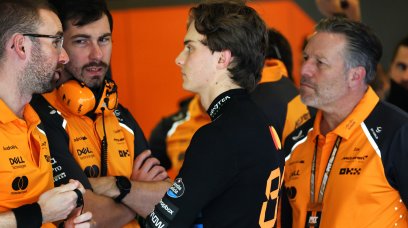This season may seem like a campaign of paradoxes and this rings no truer than the predictability of the performance of the SF-23 across various types of tracks, depending on characteristics. It was surprising how, despite Frederic Vasseur's cautious expectations on the eve of the Belgian Grand Prix, the SF-23 denied the declarations to all intents and purposes - Leclerc taking second place in qualifying [which due to the effect of the five-place penalty suffered by Verstappen for replacing the gearbox earned him pole position] and third in the race. It is therefore imperative to find a reason for the unexpected competitiveness of the Scuderia's machinery. At Spa-Francorchamps, Ferrari introduced a low-downforce rear wing characterised by an interesting construction between the flap and the endplates. This is the adoption of a connection with a particularly small section, a solution also adopted by AlphaTauri in Hungary [with a maximum downforce load configuration and therefore with a totally different function]. It emerged that this configuration - in addition to the fact that the entire construction of the new Ferrari wing is made with an ultra-light structure - has allowed the adoption of a set-up characterised by reduced ride heights and a rear axle capable of absorbing progressive high loads [especially at Eau Rouge], to give an extremely homogeneous behaviour of the car in all sectors of the Belgian track. One of the negative characteristics of this car, its unpredictability mid-corner is being addressed by the increased efficiency of the diffuser thanks to the new wing, also modified in the lower profile [beam wing], which has once again given confidence in terms of behaviour in fast corners. Leclerc conceded that he had changed his driving style making it more progressive and less aggressive when entering corners. This could certainly have contributed to the positive performance, but it seems obvious that the crucial factor was the optimal balance achieved thanks to the car's mix of aerodynamic and dynamic adjustments. In short, the potential of the SF-23 - at least on an extremely technical track like Spa - seems to find a greater possibility of expression in the conditions that favour the load generated by the floor compared to the wings. It appears as a reversal of the characteristics of the SF-23 compared to those seen at the beginning of the season.
SF-23 rear wing SPA and Baku version comparison
The adoption of a flap characterised by a miniaturised connection with the endplate was interesting. The new version introduced in Belgium also concerned a different shape of the lower beam wing, in favour of an improvement in the efficiency of the diffuser, therefore with an increase in the load generated by the bottom. Furthermore, even if there were no visible signs of this development, Ferrari worked on the DRS efficiency on the Kemmel straight which proved strong in Baku even though adopting a totally different wing profile.
AlphaTauri rear wing – Budapest
In Hungary, the AT04 had adopted a rear wing with a reduced connection between flaps and bulkheads. The aim was to generate vortices at the sides of the trailing edge rather than reducing drag, as in the case of the solution adopted by Ferrari in Belgium.
Most read








